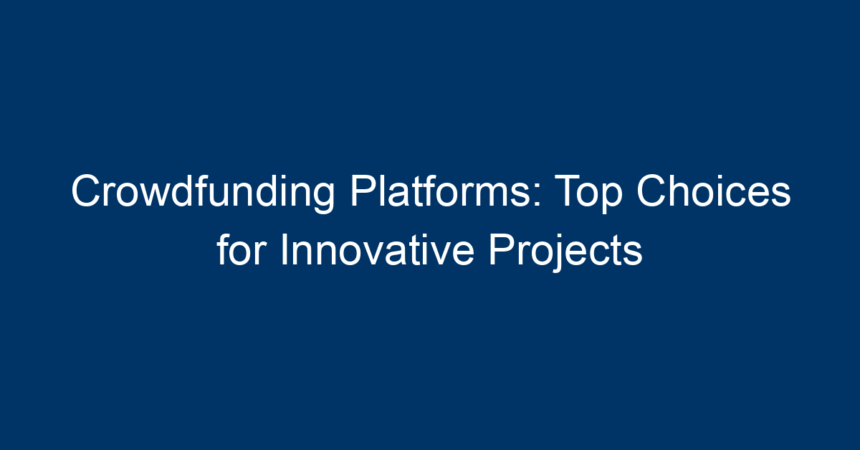In today’s digital age, innovation thrives beyond traditional funding avenues, thanks to the rise of crowdfunding platforms. Entrepreneurs, artists, and creators are finding new ways to bring their ideas to life, connecting with backers who believe in their vision. This article explores the top crowdfunding platforms available, guiding you through the options to help you choose the best fit for your innovative project.
What Are Crowdfunding Platforms?
Crowdfunding platforms serve as digital marketplaces where entrepreneurs can present their ideas and solicit financial backing from the public. Rather than relying solely on venture capitalists or personal savings, creators can harness the power of community support. This model not only provides funding but also helps validate concepts through public interest.
Types of Crowdfunding
Before diving into specific platforms, it’s important to understand the different types of crowdfunding:
- Reward-Based Crowdfunding: Backers receive a non-financial reward, such as a product or experience, in return for their contributions.
- Equity Crowdfunding: Investors receive a stake in the company for their financial support.
- Debt Crowdfunding: Also known as peer-to-peer lending, backers lend money expecting repayment with interest.
- Donation-Based Crowdfunding: Individuals donate to a cause without expecting any returns.
Top Crowdfunding Platforms for Innovative Projects
1. Kickstarter
Overview: Launched in 2009, Kickstarter is one of the most popular crowdfunding platforms, known for its ability to fund creative projects.
Best For: Creative endeavors, including art, music, film, and technology.
How It Works: Creators set funding goals and deadlines. If the goal isn’t met, no funds are collected, which adds an element of urgency.
Advantages:
- Large and active community of potential backers.
- Simple user interface.
- Offers a wide range of categories to fit various projects.
Disadvantages:
- All-or-nothing funding means risk for creators.
- High competition for visibility.
2. Indiegogo
Overview: Indiegogo offers flexibility with funding options, catering to a broad spectrum of projects ranging from innovative startups to personal causes.
Best For: Diverse projects, including technology, design, and social impact initiatives.
How It Works: Creators can choose between fixed or flexible funding. Fixed requires a specific goal, while flexible allows creators to keep whatever funds they raise, even if they don’t meet their goal.
Advantages:
- Flexible funding options.
- Option to pre-sell products.
- A vast global audience.
Disadvantages:
- Slightly lower visibility compared to Kickstarter for some categories.
- Fees can be higher for flexible funding options.
3. GoFundMe
Overview: Primarily known for personal fundraising, GoFundMe is an excellent choice for charitable causes and individual projects.
Best For: Personal projects, medical expenses, and charitable causes.
How It Works: Users set a fundraising goal and create a campaign page to share via social media or email. Unlike traditional crowdfunding, there is no deadline.
Advantages:
- No goal requirement means you can raise funds at your own pace.
- User-friendly interface.
- Strong community support for personal causes.
Disadvantages:
- Limited in marketing tools for campaign promotion.
- Not ideal for product-based startups.
4. SeedInvest
Overview: A leader in equity crowdfunding, SeedInvest allows startups to raise capital from accredited investors.
Best For: Established startups looking for serious investment.
How It Works: Companies can pitch their business to potential investors, offering equity in return.
Advantages:
- Access to a pool of accredited investors.
- Equity crowdfunding can lead to significant financial backing.
- Strong vetting process increases trust among backers.
Disadvantages:
- Requires a business plan and financial transparency.
- Suitable mostly for established businesses, not for creative projects.
5. Patreon
Overview: While not a traditional crowdfunding platform, Patreon allows creators to earn continuous support from their audience through subscriptions.
Best For: Artists, musicians, and content creators looking for ongoing financial support.
How It Works: Creators offer different membership tiers, each providing various perks to backers.
Advantages:
- Creates a sustainable income stream.
- Builds a loyal community around your work.
- Flexibility in offerings for different tiers.
Disadvantages:
- Requires consistent content creation.
- Not ideal for one-off project funding.
Choosing the Right Crowdfunding Platform
Select the perfect crowdfunding platform by considering the following factors:
1. Project Type
Determine whether your project is a product, a service, or a charitable cause. Choose a platform that aligns with your project goals.
2. Target Audience
Identify your target audience and determine where they are most active. Platforms with niche communities might be more beneficial for specialized projects.
3. Funding Model
Decide if you need all-or-nothing funding or prefer a more flexible approach. Each model presents different risks and rewards.
4. Marketing Tools
Examine the promotional features offered by each platform. Some may provide better support for campaign visibility than others.
5. Fees and Costs
Review the fee structure of each crowdfunding platform. Understanding the costs involved will help you set a realistic funding goal.
Tips for a Successful Crowdfunding Campaign
To maximize your chances of success, consider the following tips:
-
Engaging Storytelling: Craft a compelling narrative that resonates with potential backers. Use engaging visuals, videos, and clear descriptions to convey your message.
-
Set Realistic Goals: Be honest about how much funding you need and what you can realistically deliver in return for support.
-
Promote Your Campaign: Utilize social media, your personal network, and influencer partnerships to increase visibility.
-
Provide Updates: Keep your backers informed throughout the campaign. Regular updates encourage ongoing support and build trust.
- Celebrate Milestones: Acknowledge your backers’ contributions and celebrate reaching goals. This fosters community involvement and loyalty.
Conclusion
Crowdfunding platforms open doors for innovative projects to flourish. From artistic endeavors to technological advancements, there’s a platform out there to suit your needs. By understanding the different types of crowdfunding and carefully selecting the right platform, you can successfully fund your project while engaging with a community of supporters.
Remember, success in crowdfunding requires clear planning, a compelling narrative, and proactive engagement. Harness the power of crowdfunding platforms to turn your dreams into reality. Start your journey today and watch as your innovative ideas come to life with the support of the crowd!




